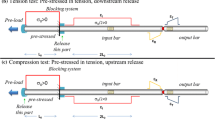Abstract
A direct-tension split-Hopkinson-bar apparatus is introduced. In this apparatus the specimen is loaded by a tensile wave that is generated by the release of a stored load in a section of the input bar. The system can be used for experiments with test durations of up to 500 μs. The effect of specimen geometry (length to diameter ratio) is investigated. Consistent results are obtained when the ratio is larger than about 1.60. Results from tests with 6061-T651 aluminum are in agreement with published data.
Similar content being viewed by others
References
Kolsky, H., “An Investigation of the Mechanical Properties of Materials at Very High Rates of Loading,”Proc. Phys. Soc., London,62-B,676–700 (1949).
Lindholm, U.S. andYeakley, L.M., “High Strain-rate Testing: Tension and Compression,”Experimental Mechanics,8 (1),1–9 (1968).
Nicholas, T., “Tensile Testing of Materials at High Rates of Strain,”Experimental Mechanics,21 (5),177–185 (1981).
Harding, J. andWelsh, L.M., “A Tensile Testing Technique for Fibre-Reinforced Composites at Impact Rates of Strain,”J. Mat. Sci.,18,1810–1826 (1983).
Nicholas, T. andBless, S.J., “High Strain Rate Tension Testing,”Metals Handbook, 9th Ed., Amer. Soc. Metals,8,208–214 (1985).
Nicholas, T., “Material Behavior at High Strain Rates,” Chapt. 8, Impact Dynamics, ed. J.A. Zukas, T. Nicholas, H.F. Swift, L.B. Greszczuk and D.R. Curran, John Wiley and Sons (1982).
Gilat, A. andPao, Y.H., “High-Rate Decremental-Strain-Rate Test,”Experimental Mechanics,28 (3),322–325 (1988).
Bertholf, L.D. andKarnes, C.H., “Two-Dimensional Analysis of the Split Hopkinson Pressure Bar System,”J. Mech. Phys. Solids,23,1–19 (1975).
Follansbee, P.S. andFrantz, C., “Wave Propagation in the Split Hopkinson Pressure Bar,”ASME J. Eng. Mat. and Tech.,105,61–66 (1983).
Lindholm, U.S., Bessey, R.L. andSmith, G.V., “Effect of Strain Rate on Yield Strength, Tensile Strength, and Elongation of Three Aluminum Alloys,”J. Mat.,6,119–133 (1971).
Author information
Authors and Affiliations
Rights and permissions
About this article
Cite this article
Staab, G.H., Gilat, A. A direct-tension split Hopkinson bar for high strain-rate testing. Experimental Mechanics 31, 232–235 (1991). https://doi.org/10.1007/BF02326065
Received:
Revised:
Issue Date:
DOI: https://doi.org/10.1007/BF02326065




